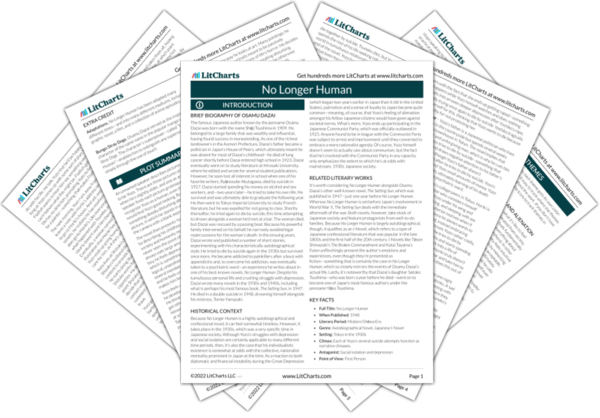In many ways, No Longer Human is a testament to the human tendency to naturally gravitate toward self-expression. Even though Yozo goes to great lengths in his everyday life to conceal his inner thoughts and feelings, he’s still drawn to certain modes of self-expression that allow him to represent his “true nature.” When he’s an adolescent, for instance, he discovers that painting can be an outlet of sorts, since the artform provides him with a way to recreate his general worldview. He has always been good at drawing cartoons, but he spends most of his childhood doing so simply as a way of pleasing his peers, catering to their preferences as a way of masking what he sees as his authentic self. When his classmate Takeichi mistakenly suggests that a self-portrait by Van Gogh is actually a painting of a ghost, though, Yozo is astounded—the comment helps him realize that art doesn’t always have to be straightforward, beautiful, or entertaining; it can also be frightening, heavy, and expressive. With this in mind, he begins creating disturbing paintings that reveal “the true self [he has] so desperately hidden.” In this way, art becomes the only way that Yozo feels comfortable expressing himself (though he only shows the paintings to Takeichi). More importantly, though, his interest in art shows that he yearns for some kind of outlet, despite the fact that he otherwise works so hard to hide his internal emotional landscape.
In addition, the format of No Longer Human plays into the idea that Yozo longs for self-expression even if he also abhors the idea of actually revealing anything about himself to others. After all, the majority of the novel itself is made up of Yozo’s (fictional) notebooks, in which he has spent pages upon pages trying to precisely articulate his thoughts and feelings. The fact that he has put so much effort into expressing himself suggests that even the most guarded, private people often experience the urge to explore certain parts of themselves through art. And though his notebook entries are presumably intended to be private documents of his life, he ends up sending them to an old bartender he used to know, indicating that he has finally decided to open up to the world after decades of stifling privacy.
Self-Expression, Privacy, and Art ThemeTracker

Self-Expression, Privacy, and Art Quotes in No Longer Human
How often as I lay there I used to think what uninspired decorations sheets and pillow cases make. It wasn’t until I was about twenty that I realized that they actually served a practical purpose, and this revelation of human dullness stirred dark depression in me.

Unlock explanations and citation info for this and every other No Longer Human quote.
Plus so much more...
Get LitCharts A+There are some people whose dread of human beings is so morbid that they reach a point where they yearn to see with their own eyes monsters of ever more horrible shapes. And the more nervous they are—the quicker to take fright—the more violent they pray that every storm will be…Painters who have had this mentality, after repeated wounds and intimidations at the hands of the apparitions called human beings, have often come to believe in phantasms—they plainly saw monsters in broad daylight, in the midst of nature. And they did not fob people off with clowning; they did their best to depict these monsters just as they had appeared.
The pictures I drew were so heart-rending as to stupefy even myself. Here was the true self I had so desperately hidden. I had smiled cheerfully; I had made others laugh; but this was the harrowing reality. I secretly affirmed this self, was sure that there was no escape from it, but naturally I did not show my pictures to anyone except Takeichi.
Why, I wonder, couldn’t he have mentioned the simple fact that the money would be forthcoming from home? That one fact would probably have settled my feelings, but I was left in a fog.
“How about it? Have you anything which might be described as aspirations for the future? I suppose one can’t expect people one helps to understand how difficult it is to help another person.”











